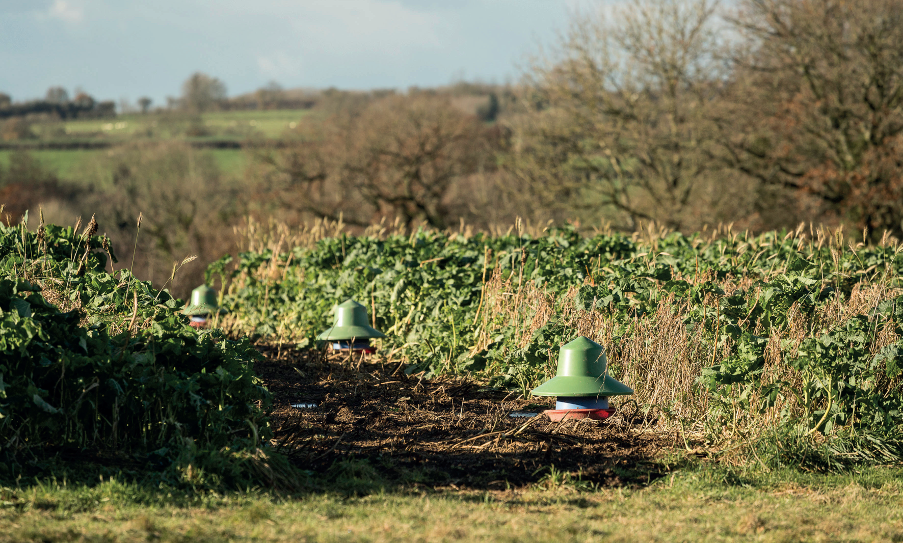News
Grow your own way
The use of game cover for shoots has changed drastically in recent years, says Felix Petit, driven by an increase in government grants
Would you like to speak to our readers? We offer sponsored articles and advertising to put you in front of our audience. Find out more.
Gamekeepers and estate owners are taking their gamecrops increasingly seriously, and with good reason. The advantages that a gamecrop can bring to birds, both native and released, as well as to the insects and soil, are gradually becoming better understood. The launch of the Sustainable Farming Incentive (SFI) over the past few years has provided further motivation for land managers to focus on gamecrops, because besides the rewards they bring for biodiversity, they can also offer a welcome extra source of income in the form of government grants.
Although straightforward single-species game strips of kale or maize are not uncommon, some estates are getting much more technical about what they plant. On an estate just outside Paris, where I shot wild grey partridge before Christmas (Purple patch with a new Browning, 15 January), they have made the game strip into an art form.
They had striated plantations 500m long with a line of maize a few metres wide nestled up against a stripe of sorghum. Next to the sorghum were a few metres of canary grass, which then gave way to a several metres of cropped rye grass to allow the free movement of partridge chicks. The icing on the cake was a final band drilled with a meadow mix. Each layer had a specific function, whether it be shelter, food or mobility.
Economies of scale
The practice of planting specific crops to benefit gamebirds has only been around in a meaningful way since World War II. Before this, farms were generally smaller and largely mixed, keeping both livestock as well as fodder crops. As small farms became less
viable and farmers came to realise the benefits of economies of scale, food producers began to enlarge and specialise, leading to the decline of mixed farming.
Dr Mike Swan, senior adviser to the GWCT, says: “The rise of dedicated covercrops for shooting is really the result of numerous changes in farming over the decades. In the mixed-farming environment, the average keeper had little need for dedicated gamecrops; he could simply drive what the farms provided.”
This format worked 70 years ago, but keepers had little control over where the game strips were positioned because this was a decision made by the farmer to benefit the business and run in line with crop rotations. With changes to farming practices such as the phasing out of strip-grazing, this gave rise to the range
of game covercrops similar to those we see today, and allowed the keeper to position game strips in ways that were more closely aligned with the requirements of the shoot.
As shooting operations have intensified, climate change has occurred and there has been an increasing interest in biodiversity on an individual and governmentally incentivised basis, the demand for gamecrops has continued to develop. The planting and maintenance of gamecrops have a similar raft of issues to arable farming, but they are also garnished with many further gamebird- and vermin-based pitfalls.
Subsidies
Perhaps the greatest shake-up to the world of gamecrops in recent years has been the evolving raft of subsidies. Richard Crofts, director of RC Sporting, says: “There is no doubt that more and more shoots are using wild bird seed mixtures to drive game from. Financially it’s a no-brainer, but some mixtures are better than others.” Richard urges people not to plant crops that are too thick, as it makes it more difficult to lift the birds.
Richard also reveals that many people don’t treat gamecrops with the same care that they would an arable crop, which is a mistake if you still want it to grow well. Richard passionately
advocates for soil sampling to get the lie of land, as this gives land managers an idea of what will grow best.
“Having crops fail or grow sporadically is no good and will have a massive impact on your shooting season,” he explains. “The financial impact of poor crops, with pheasants and partridges flushing in big numbers, can be devastating.”
With the advent of SFI, wild bird mixes have become profitable and thus more popular. Richard says that despite this, keeping mixes like this weed-free can present real problems. He believes that AHL2 winter bird food schemes offer the best option for growing game covers, but he still thinks that cobless maize, which is not covered under the schemes, provides one of the best habitats for gamebirds.
Will Shepherd, director of Shepherd Seeds, says he has certainly seen a rise in popularity of seed mixes that are compatible with SFI. He believes that a far higher number of keepers are working to create greater biodiversity on their shoots, but this requires bravery in terms of altering their tried-and-tested seed mixes. He says: “We always suggest doing soil samples and a site analysis before jumping in with both feet and changing a well-known and successful covercrop mixture. In the past, we have suggested adding new species to existing mixtures to slowly introduce them to the shoot.”
If there is significant apprehension associated with a change in gamecrop, Will encourages landowners and gamekeepers to visit their trial sites in Lincolnshire and Norfolk to see single-crop species and new mixtures actually growing in varied soil types.
Will urges shoots to avoid “group thinking” where possible and not to plant a particular species of gamecrop just because their neighbours are doing it. He often sees planting that is not suited to the soil, location or even region simply because the shoot is following the lead of a neighbour.
Another problem Will observes, particularly on syndicate shoots where members do the keeping and planting themselves, is placing covercrops at the wrong point in the year, usually when someone has the spare time or in order to fit in with spring drilling on other parts of the farm. To maximise growth, it is essential that a crop is drilled at the correct time of year when the seedbed is the right temperature.
Finally, Will says the rising cost of shooting has led to more customers wanting to discuss multi-season covercrop options, such as chicory and canary grass-based mixtures, as well as mixes that are suitable for broadcasting rather than drilling due to the cost of contractors. Will says this is because generally shoots try to “cut costs elsewhere before they look at reducing the number of birds they put down”.
Fact-finding mission
Chris Bright, managing director of Bright Seeds, says the changes stimulated by SFI turned last season into something of a fact-finding mission, where the industry was still discovering how new mixes would perform. He’s found that, due to the recent incentives, land managers planted so much cover that “the birds were all over the place”.
Chris says while the birds certainly thrived due to the vast scale of all the subsidy-motivated covercrop planting, it was difficult to predict where the birds were going to go, a little like wildfowling after heavy flooding. For Chris, the selection of covercrop is crucial. It mustn’t be so thick that it provides too much winter holding capability because then it becomes
very difficult to push and pull the birds where they are desired.
Chris also advocates choosing a crop that relates to the birds you wish to promote – something with small seeds for grey partridge chicks – and the weeds you most regularly suffer. He says there is “no point in putting in a broadleaf mixture if you have broadleaf weeds, or a grass-type mixture if you are susceptible to grass weed problems, as this gives you no chemical control to prevent them getting worse”.
Food and shelter
Dawn Collins, managing director of Collins Nets, and her supplier Henry Cossins from Pearce Seeds, agree that the increase of the size of the covercrop plots thanks to the payments have substantially altered shoots.
Henry says: “The addition of whole parcels of land being put into wild bird mix or pollen and nectar mixes has, in some cases, encouraged birds to wander more and disperse into these large covers. In other cases, it’s aided shoots in holding birds better in certain areas due to the increased food and shelter.”
He continues: “The mixes under SFI have greatly increased biodiversity by bringing new plants and insects to areas that were previously deficient.”
Covercrops are usually sited in the same place year after year, which can lead to a build-up of weeds. This can hamper crops in the long run, particularly as gamecrops are usually situated on marginal ground in the first place. If this is the case, Dawn recommends a soil sample to determine what species might thrive and to allow for the correction of soil deficiencies if necessary.
Dawn relates how the SFI-approved multi-seed mixes have dramatically reduced the use of herbicides due to the variety of species they contain. She reveals that insecticides are now rarely used on covercrops, as “even the flea beetle on brassicas is almost always resistant”.
Path of change
New payment schemes have certainly set the sector on a path of change, and biodiversity already seems to be benefiting. Covercrop selection is still a highly technical business, with an awful lot of variables to navigate if your plantation is to be a financial, floral and faunal success, but it seems help is at hand. If in doubt, speak to the experts.
Related articles
News
Anti-grouse shooting petition crushed by MPs who don't even shoot
Wild Justice's petition to ban driven grouse shooting was quashed in Westminster Hall yesterday, with all but one MP opposing the ban
By Time Well Spent
News
A sound decision as moderators to be taken off licences
The Government has finally confirmed what the shooting community has long argued – that sound moderators should be removed from firearms licensing controls
By Time Well Spent
Manage Consent
To provide the best experiences, we use technologies like cookies to store and/or access device information. Consenting to these technologies will allow us to process data such as browsing behavior or unique IDs on this site. Not consenting or withdrawing consent, may adversely affect certain features and functions.
Functional Always active
The technical storage or access is strictly necessary for the legitimate purpose of enabling the use of a specific service explicitly requested by the subscriber or user, or for the sole purpose of carrying out the transmission of a communication over an electronic communications network.
Preferences
The technical storage or access is necessary for the legitimate purpose of storing preferences that are not requested by the subscriber or user.
Statistics
The technical storage or access that is used exclusively for statistical purposes.
The technical storage or access that is used exclusively for anonymous statistical purposes. Without a subpoena, voluntary compliance on the part of your Internet Service Provider, or additional records from a third party, information stored or retrieved for this purpose alone cannot usually be used to identify you.
Marketing
The technical storage or access is required to create user profiles to send advertising, or to track the user on a website or across several websites for similar marketing purposes.





